A Novel Low-Power High-Precision Implementation for Sign–Magnitude DLMS Adaptive Filters
Abstract
:1. Introduction
2. Materials and Methods
2.1. Delayed LMS Algorithm
2.2. Sign–Magnitude Error Representation
2.3. Fixed-Width Approximation
2.3.1. Fixed-Width MAC Block in the Feedback
2.3.2. Fixed-Width Approximation in the FIR Section
2.4. Approximation with the Static Segment Method
2.4.1. Static Segment Method
2.4.2. Approximation with the Static Segment Method in the Feedback Section
3. Results
3.1. Assessment of the Precision Performances
- (i)
- Low pass, 38-th order, Equiripple FIR filter with pass band up to 0.4167π rad/sample and stop band with attenuation of 75 dB from 0.5417π rad/sample;
- (ii)
- Low pass, 7-th order, Infinite Impulse Response (IIR) filter with pass band up to 0.4167π rad/sample and stop band with attenuation of 60 dB from 0.75π rad/sample.
3.2. Assessment of the Electrical Performances
4. Discussion
5. Conclusions
Author Contributions
Funding
Data Availability Statement
Conflicts of Interest
References
- Haykin, S. Adaptive Filter Theory; Prentice-Hall: Hobeken, NJ, USA, 2002. [Google Scholar]
- Rahman, M.Z.U.; Shaik, R.A.; Reddy, D.V.R.K. Adaptive noise removal in the ECG using the Block LMS algorithm. In Proceedings of the 2009 2nd International Conference on Adaptive Science & Technology (ICAST), Accra, Ghana, 14–16 December 2009; pp. 380–383. [Google Scholar] [CrossRef]
- Gupta, S.; Sharma, J.B. Estimation of respiratory rate from the ECG using instantaneous frequency tracking LMS algorithm. In Proceedings of the 2016 2nd International Conference on Advances in Computing, Communication, & Automation (ICACCA) (Fall), Bareilly, India, 30 September–1 November 2016; pp. 1–5. [Google Scholar] [CrossRef]
- Montanari, D.; Castellano, G.; Kargaran, E.; Pini, G.; Tijan, S.; De Caro, D.; Strollo, A.G.M.; Manstretta, D.; Castello, R. An FDD Wireless Diversity Receiver With Transmitter Leakage Cancellation in Transmit and Receive Bands. IEEE J. Solid-State Circuits 2018, 53, 1945–1959. [Google Scholar] [CrossRef]
- Colieri, S.; Ergen, M.; Puri, A.; Bahai, A. A study of channel estimation in OFDM systems. In Proceedings of the IEEE 56th Vehicular Technology Conference, Vancouver, BC, Canada, 24–28 September 2002; Volume 2, pp. 894–898. [Google Scholar] [CrossRef]
- Ting, L.K.; Woods, R.; Cowan, C.F.N. Virtex FPGA implementation of a pipelined adaptive LMS predictor for electronic support measures receivers. IEEE Trans. Very Large Scale Integr. (VLSI) Syst. 2005, 13, 86–95. [Google Scholar] [CrossRef]
- Albu, I.; Anghel, C.; Paleologu, C. Adaptive filtering in acoustic echo cancellation systems—A practical overview. In Proceedings of the 2017 9th International Conference on Electronics, Computers and Artificial Intelligence (ECAI), Piscataway, NJ, USA, 29 June–1 July 2017; pp. 1–6. [Google Scholar] [CrossRef]
- Yuan, Z.; Songtao, X. Application of new LMS adaptive filtering algorithm with variable step size in adaptive echo cancellation. In Proceedings of the 2017 IEEE 17th International Conference on Communication Technology (ICCT), Chengdu, China, 27–30 October 2017; pp. 1715–1719. [Google Scholar] [CrossRef]
- Tingchan, W.; Benjangkaprasert, C.; Sangaroon, O. Performance comparison of adaptive algorithms for multiple echo cancellation in telephone network. In Proceedings of the 2007 International Conference on Control, Automation and Systems, Seoul, Korea, 17–20 October 2007; pp. 789–792. [Google Scholar] [CrossRef]
- Meher, P.K.; Park, S.Y. Critical-Path Analysis and Low-Complexity Implementation of the LMS Adaptive Algorithm. IEEE Trans. Circuits Syst. I Regul. Pap. 2014, 61, 778–788. [Google Scholar] [CrossRef]
- Meyer, M.D.; Agrawal, D.P. A modular pipelined implementation of a delayed LMS transversal adaptive filter. In Proceedings of the 1990 IEEE International Symposium on Circuits and Systems (ISCAS), New Orleans, LA, USA, 1–3 May 1990; Volume 3, pp. 1943–1946. [Google Scholar] [CrossRef]
- Meher, P.K.; Park, S.Y. Area-Delay-Power Efficient Fixed-Point LMS Adaptive Filter With Low Adaptation-Delay. IEEE Trans. Very Large Scale Integr. (VLSI) Syst. 2014, 22, 362–371. [Google Scholar] [CrossRef]
- Long, G.; Ling, F.; Proakis, J.G. The LMS algorithm with delayed coefficient adaptation. IEEE Trans. Acoust. Speech Signal Process. 1989, 37, 1397–1405. [Google Scholar] [CrossRef]
- Mahfuz, E.; Wang, C.; Ahmad, M.O. A high-throughput DLMS adaptive algorithm. In Proceedings of the 2005 IEEE International Symposium on Circuits and Systems (ISCAS), Kobe, Japan, 23–26 May 2005; Volume 4, pp. 3753–3756. [Google Scholar] [CrossRef]
- Meher, P.K.; Maheshwari, M. A high-speed FIR adaptive filter architecture using a modified delayed LMS algorithm. In Proceedings of the 2011 IEEE International Symposium of Circuits and Systems (ISCAS), Piscataway, NJ, USA, 15–18 May 2011; pp. 121–124. [Google Scholar] [CrossRef]
- Liu, M.; Wang, M. An Efficient Architecture for the Modified DLMS Algorithm Using CIC Filters. In Proceedings of the 2018 Eighth International Conference on Instrumentation & Measurement, Computer, Communication and Control (IMCCC), Harbin, China, 19–21 July 2018; pp. 304–310. [Google Scholar] [CrossRef]
- Khan, M.T.; Shaik, R.A. Optimal Complexity Architectures for Pipelined Distributed Arithmetic-Based LMS Adaptive Filter. IEEE Trans. Circuits Syst. I Regul. Pap. 2019, 66, 630–642. [Google Scholar] [CrossRef]
- Guo, R.; DeBrunner, L.S. Two High-Performance Adaptive Filter Implementation Schemes Using Distributed Arithmetic. IEEE Trans. Circuits Syst. II Express Briefs 2011, 58, 600–604. [Google Scholar] [CrossRef]
- Vinitha, C.S.; Sharma, R.K. Area and Energy-efficient Approximate Distributive Arithmetic architecture for LMS Adaptive FIR Filter. In Proceedings of the 2020 International Conference for Emerging Technology (INCET), Belgaum, India, 5–7 June 2020; pp. 1–5. [Google Scholar] [CrossRef]
- Jiang, H.; Liu, L.; Jonker, P.P.; Elliott, D.G.; Lombardi, F.; Han, J. A High-Performance and Energy-Efficient FIR Adaptive Filter Using Approximate Distributed Arithmetic Circuits. IEEE Trans. Circuits Syst. I Regul. Pap. 2019, 66, 313–326. [Google Scholar] [CrossRef] [Green Version]
- Jiang, H.; Han, J.; Qiao, F.; Lombardi, F. Approximate Radix-8 Booth Multipliers for Low-Power and High-Performance Operation. IEEE Trans. Comput. 2016, 65, 2638–2644. [Google Scholar] [CrossRef]
- Han, J.; Orshansky, M. Approximate computing: An emerging paradigm for energy-efficient design. In Proceedings of the 2013 18th IEEE European Test Symposium (ETS), Avignon, France, 27–30 May 2013; pp. 1–6. [Google Scholar] [CrossRef]
- Chippa, V.K.; Chakradhar, S.T.; Roy, K.; Raghunathan, A. Analysis and characterization of inherent application resilience for approximate computing. In Proceedings of the 2013 50th ACM/EDAC/IEEE Design Automation Conference (DAC), New York, NY, USA, 29 May–7 June 2013; pp. 1–9. [Google Scholar] [CrossRef]
- Esposito, D.; Strollo, A.G.M.; Napoli, E.; De Caro, D.; Petra, N. Approximate Multipliers Based on New Approximate Compressors. IEEE Trans. Circuits Syst. I Regul. Pap. 2018, 65, 4169–4182. [Google Scholar] [CrossRef]
- Fritz, C.; Fam, A.T. Fast Binary Counters Based on Symmetric Stacking. IEEE Trans. Very Large Scale Integr. (VLSI) Syst. 2017, 25, 2971–2975. [Google Scholar] [CrossRef]
- Strollo, A.G.M.; Napoli, E.; de Caro, D.; Petra, N.; Meo, G.D. Comparison and Extension of Approximate 4-2 Compressors for Low-Power Approximate Multipliers. IEEE Trans. Circuits Syst. I Regul. Pap. 2020, 67, 3021–3034. [Google Scholar] [CrossRef]
- Strollo, A.G.M.; de Caro, D.; Napoli, E.; Petra, N.; di Meo, G. Low-Power Approximate Multiplier with Error Recovery using a New Approximate 4-2 Compressor. In Proceedings of the 2020 IEEE International Symposium on Circuits and Systems (ISCAS), Virtual, 10–21 October 2020; pp. 1–4. [Google Scholar] [CrossRef]
- Esposito, D.; Strollo, A.G.M.; Alioto, M. Low-power approximate MAC unit. In Proceedings of the 2017 13th Conference on Ph.D. Research in Microelectronics and Electronics (PRIME), Taormina, Italy, 12–15 June 2017; pp. 81–84. [Google Scholar] [CrossRef]
- Zervakis, G.; Tsoumanis, K.; Xydis, S.; Soudris, D.; Pekmestzi, K. Design-Efficient Approximate Multiplication Circuits Through Partial Product Perforation. IEEE Trans. Very Large Scale Integr. (VLSI) Syst. 2016, 24, 3105–3117. [Google Scholar] [CrossRef] [Green Version]
- Yang, Z.; Han, J.; Lombardi, F. Approximate compressors for error-resilient multiplier design. In Proceedings of the 2015 IEEE International Symposium on Defect and Fault Tolerance in VLSI and Nanotechnology Systems (DFTS), Amherst, MA, USA, 12–14 October 2015; pp. 183–186. [Google Scholar] [CrossRef]
- Jou, J.M.; Kuang, S.R.; der Chen, R. Design of low-error fixed-width multipliers for DSP applications. IEEE Trans. Circuits Syst. II Analog. Digit. Signal Process. 1999, 46, 836–842. [Google Scholar] [CrossRef] [Green Version]
- Kidambi, S.S.; El-Guibaly, F.; Antoniou, A. Area-efficient multipliers for digital signal processing applications. IEEE Trans. Circuits Syst. II Analog. Digit. Signal Process. 1996, 43, 90–95. [Google Scholar] [CrossRef]
- De Caro, D.; Petra, N.; Strollo, A.G.M.; Tessitore, F.; Napoli, E. Fixed-Width Multipliers and Multipliers-Accumulators with Min-Max Approximation Error. IEEE Trans. Circuits Syst. I Regul. Pap. 2013, 60, 2375–2388. [Google Scholar] [CrossRef]
- Petra, N.; de Caro, D.; Garofalo, V.; Napoli, E.; Strollo, A.G.M. Truncated Binary Multipliers with Variable Correction and Minimum Mean Square Error. IEEE Trans. Circuits Syst. I Regul. Pap. 2010, 57, 1312–1325. [Google Scholar] [CrossRef]
- Petra, N.; de Caro, D.; Garofalo, V.; Napoli, E.; Strollo, A.G.M. Design of Fixed-Width Multipliers with Linear Compensation Function. IEEE Trans. Circuits Syst. I Regul. Pap. 2011, 58, 947–960. [Google Scholar] [CrossRef]
- Narayanamoorthy, S.; Moghaddam, H.A.; Liu, Z.; Park, T.; Kim, N.S. Energy-Efficient Approximate Multiplication for Digital Signal Processing and Classification Applications. IEEE Trans. Very Large Scale Integr. (VLSI) Syst. 2015, 23, 1180–1184. [Google Scholar] [CrossRef]
- Esposito, D.; di Meo, G.; de Caro, D.; Petra, N.; Napoli, E.; Strollo, A.G.M. On the Use of Approximate Multipliers in LMS Adaptive Filters. In Proceedings of the 2018 IEEE International Symposium on Circuits and Systems (ISCAS), Florence, Italy, 27–30 May 2018; pp. 1–5. [Google Scholar] [CrossRef]
- Esposito, D.; De Caro, D.; Di Meo, G.; Napoli, E.; Strollo, A.G.M. Low-Power Hardware Implementation of Least-Mean-Square Adaptive Filters Using Approximate Arithmetic. Circuits Syst Signal Process. 2019, 38, 5606–5622. [Google Scholar] [CrossRef]
- Esposito, D.; di Meo, G.; de Caro, D.; Strollo, A.G.M.; Napoli, E. Quality-Scalable Approximate LMS Filter. In Proceedings of the 2018 25th IEEE International Conference on Electronics, Circuits and Systems (ICECS), Bordeaux, France, 9–12 December 2018; pp. 849–852. [Google Scholar] [CrossRef]
- Di Meo, G.; De Caro, D.; Napoli, E.; Petra, N.; Strollo, A.G.M. Variable-Rounded LMS Filter for Low-Power Applications. In Applications in Electronics Pervading Industry, Environment and Society; Lecture Notes in Electrical Engineering; Saponara, S., De Gloria, A., Eds.; Springer: Berlin/Heidelberg, Germany, 2020; Volume 627. [Google Scholar] [CrossRef]
- Meo, G.D.; de Caro, D.; Saggese, G.; Napoli, E.; Petra, N.; Strollo, A.G.M. A Novel Module-Sign Low-Power Implementation for the DLMS Adaptive Filter With Low Steady-State Error. IEEE Trans. Circuits Syst. I Regul. Pap. 2022, 69, 297–308. [Google Scholar] [CrossRef]
- Jakati, J.S.; Kuntoji, S.S. A Noise Reduction Method based on Modified LMS Algorithm of Real-time Speech Signals. WSEAS Trans. Syst. Control 2021, 16, 162–170. [Google Scholar] [CrossRef]
- Esposito, D.; Meo, G.D.; de Caro, D.; Napoli, E.; Petra, N.; Strollo, A.G.M. Stall-Aware Fixed-Point Implementation of LMS Filters. In Proceedings of the 2018 14th Conference on Ph.D. Research in Microelectronics and Electronics (PRIME), Prague, Czech Republic, 2–5 July 2018; pp. 169–172. [Google Scholar] [CrossRef]
- Stavrou, V.N.; Tsoulos, I.G.; Mastorakis, N.E. Transformations for FIR and IIR Filters’ Design. Symmetry 2021, 13, 533. [Google Scholar] [CrossRef]
- Tsoulos, I.G.; Stavrou, V.; Mastorakis, N.E.; Tsalikakis, D. GenConstraint: A programming tool for constraint optimization problems. SoftwareX 2019, 10, 100355. [Google Scholar] [CrossRef]
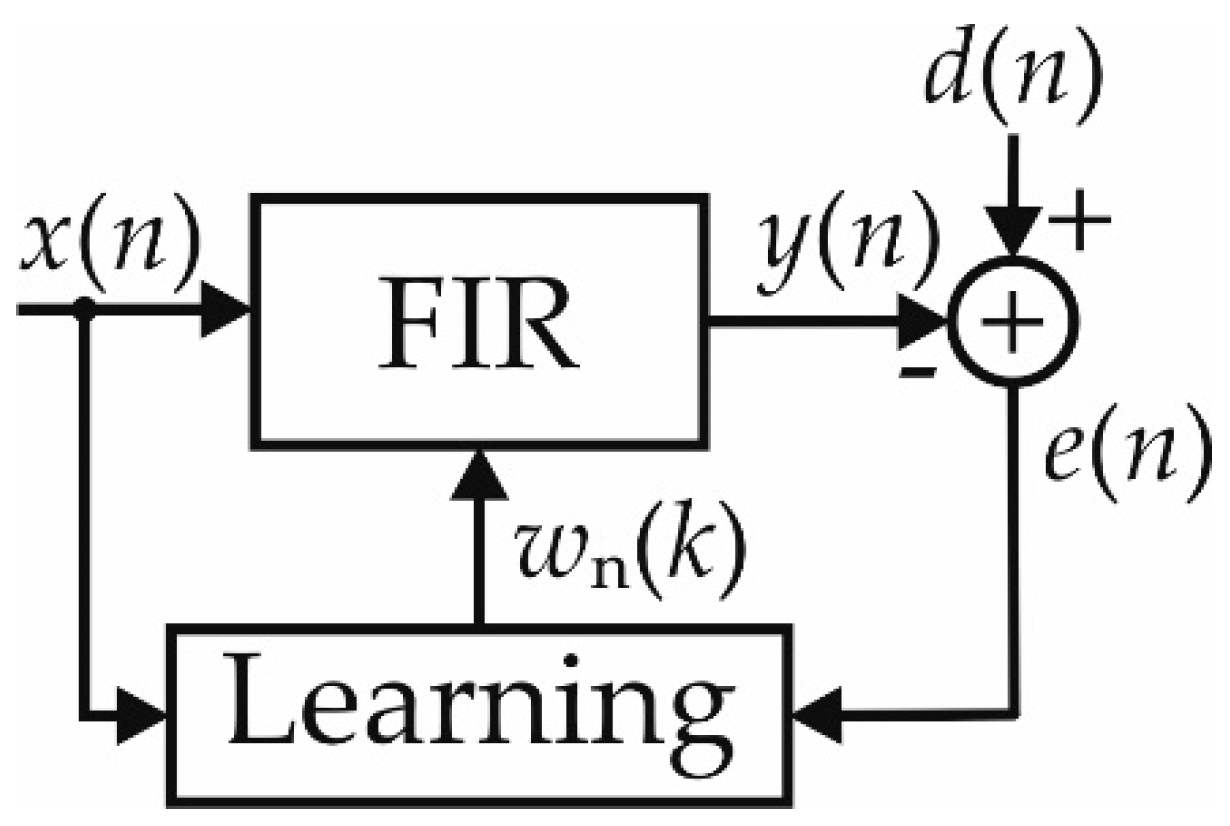



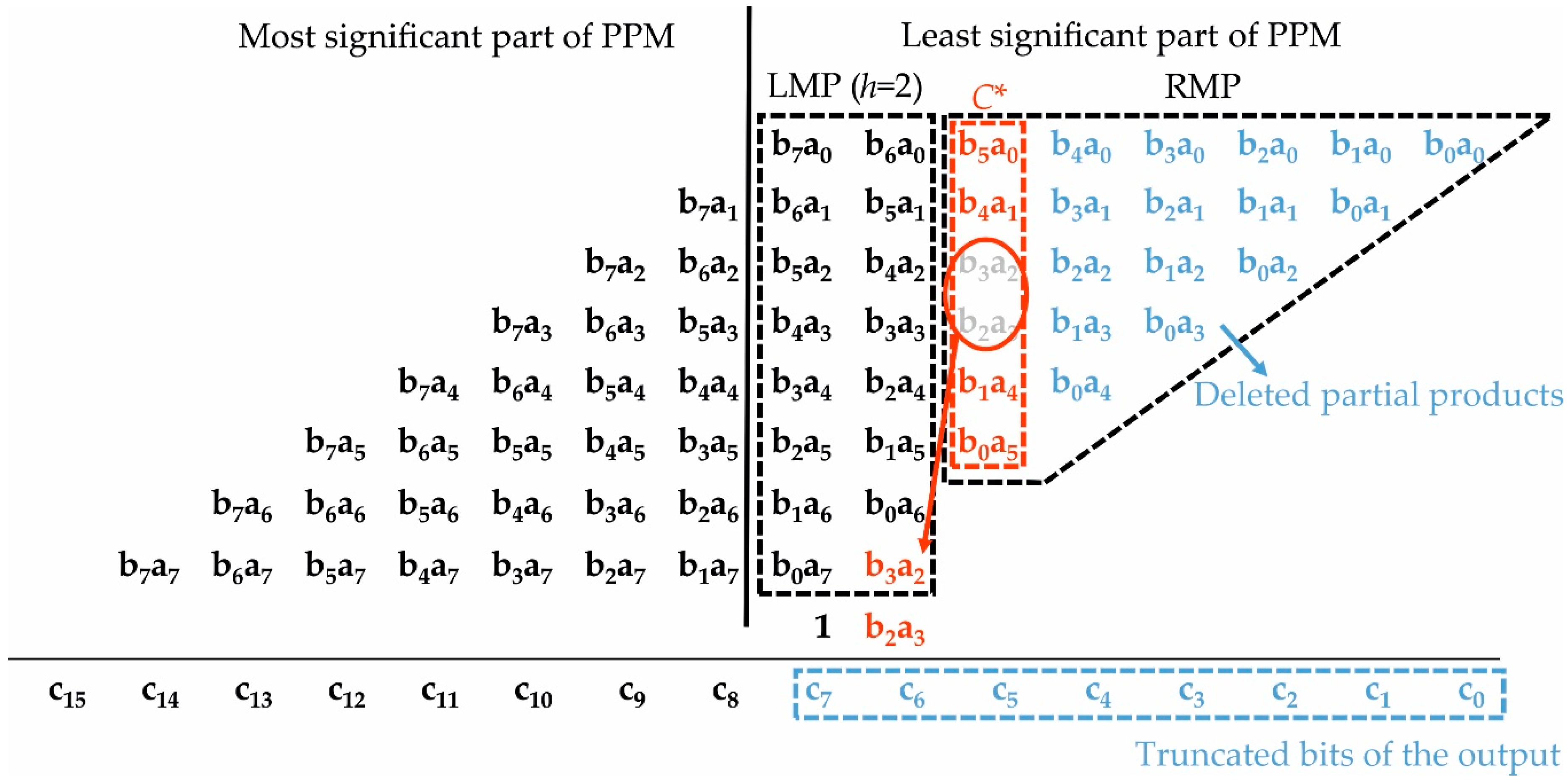
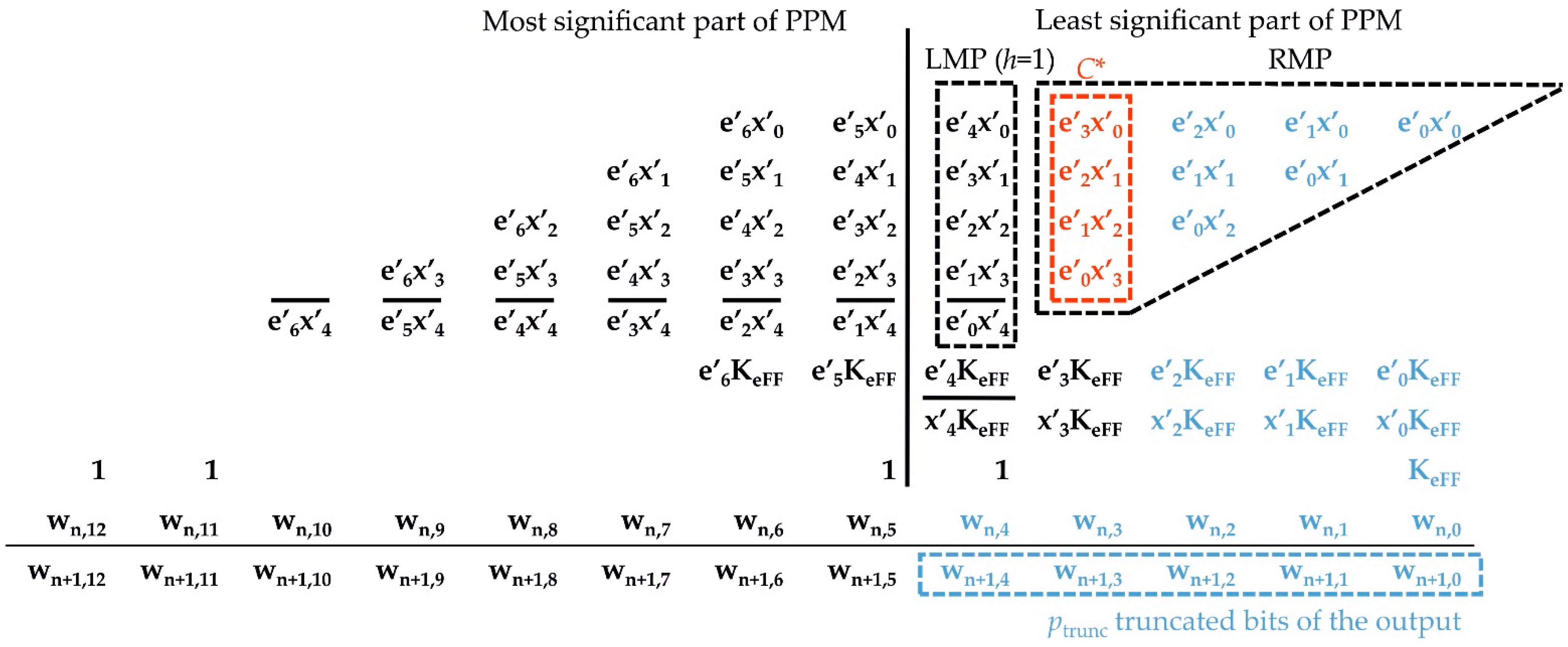
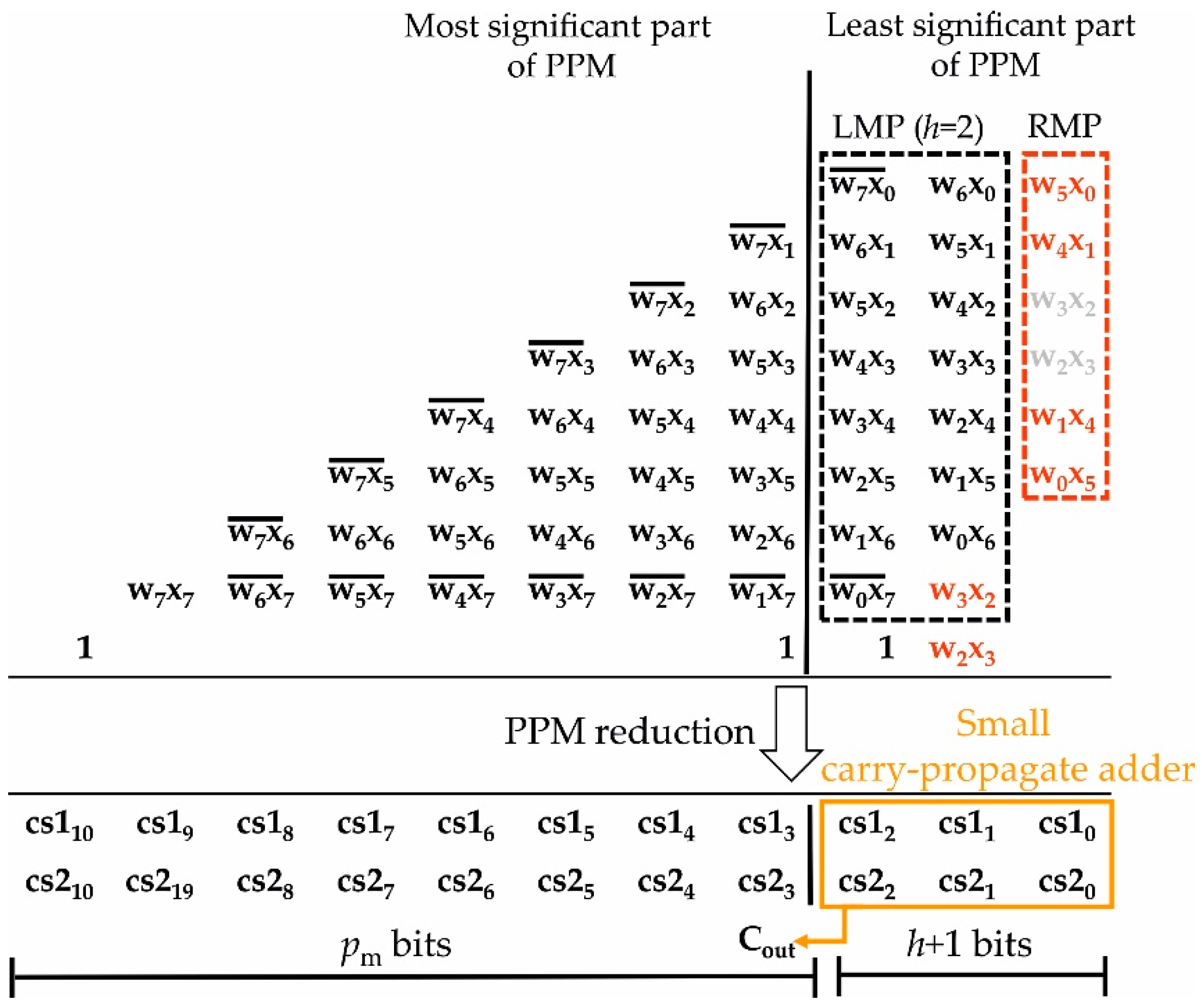
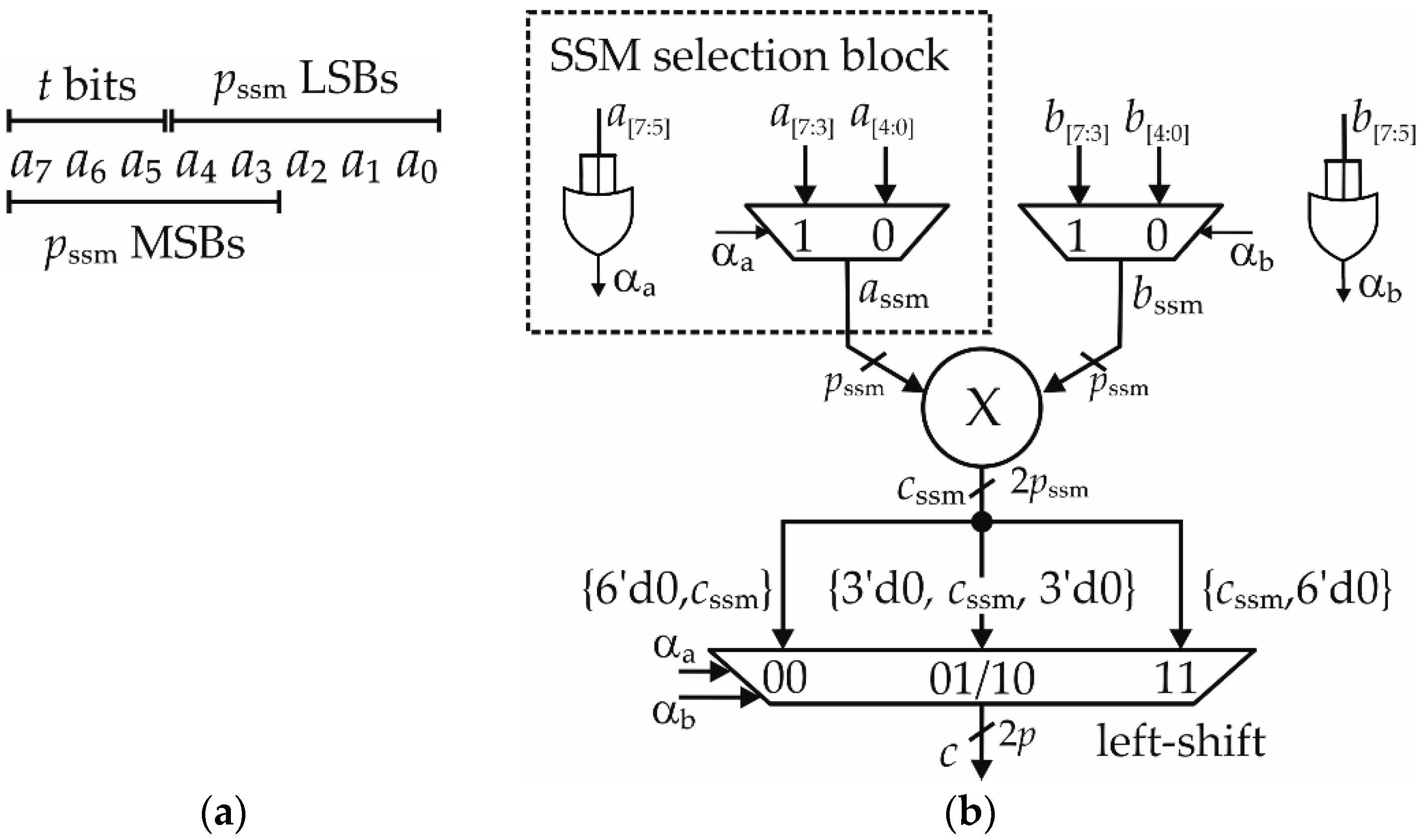
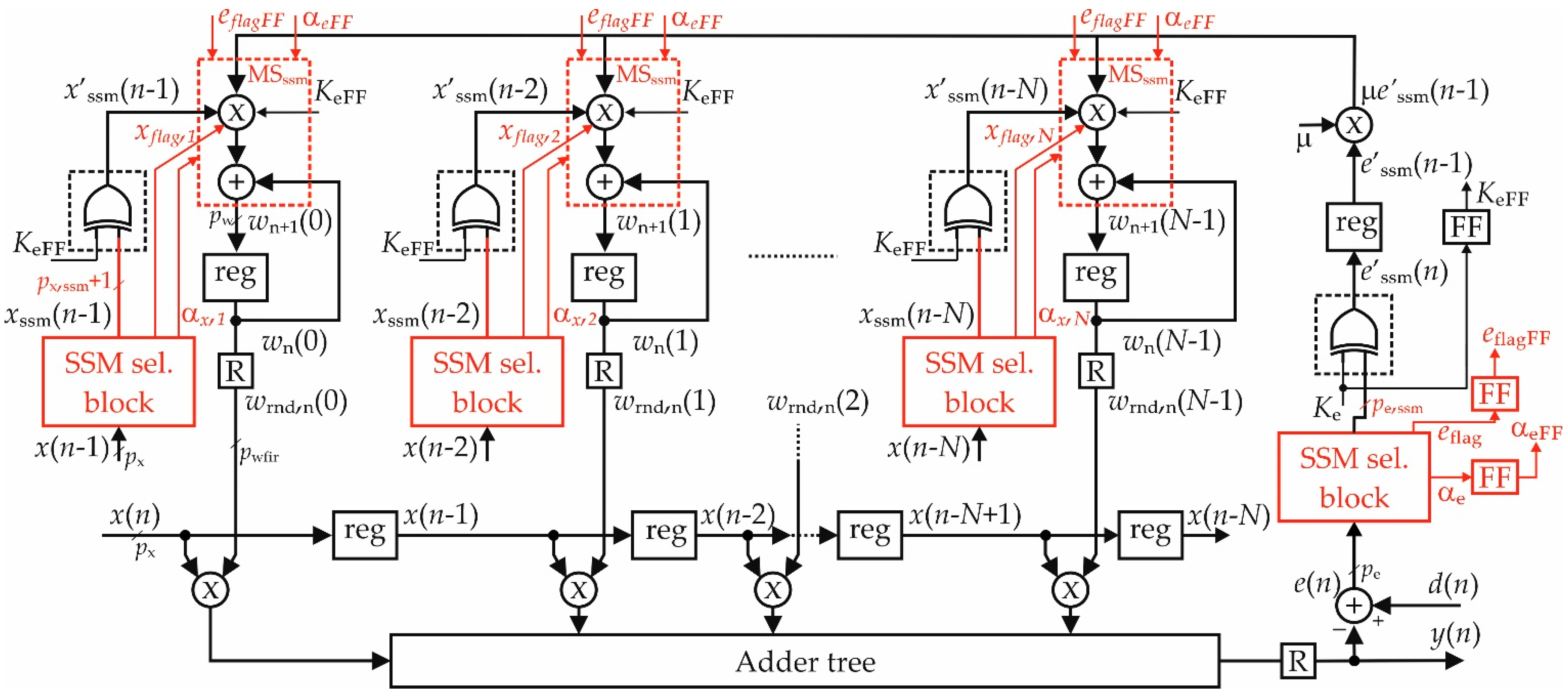

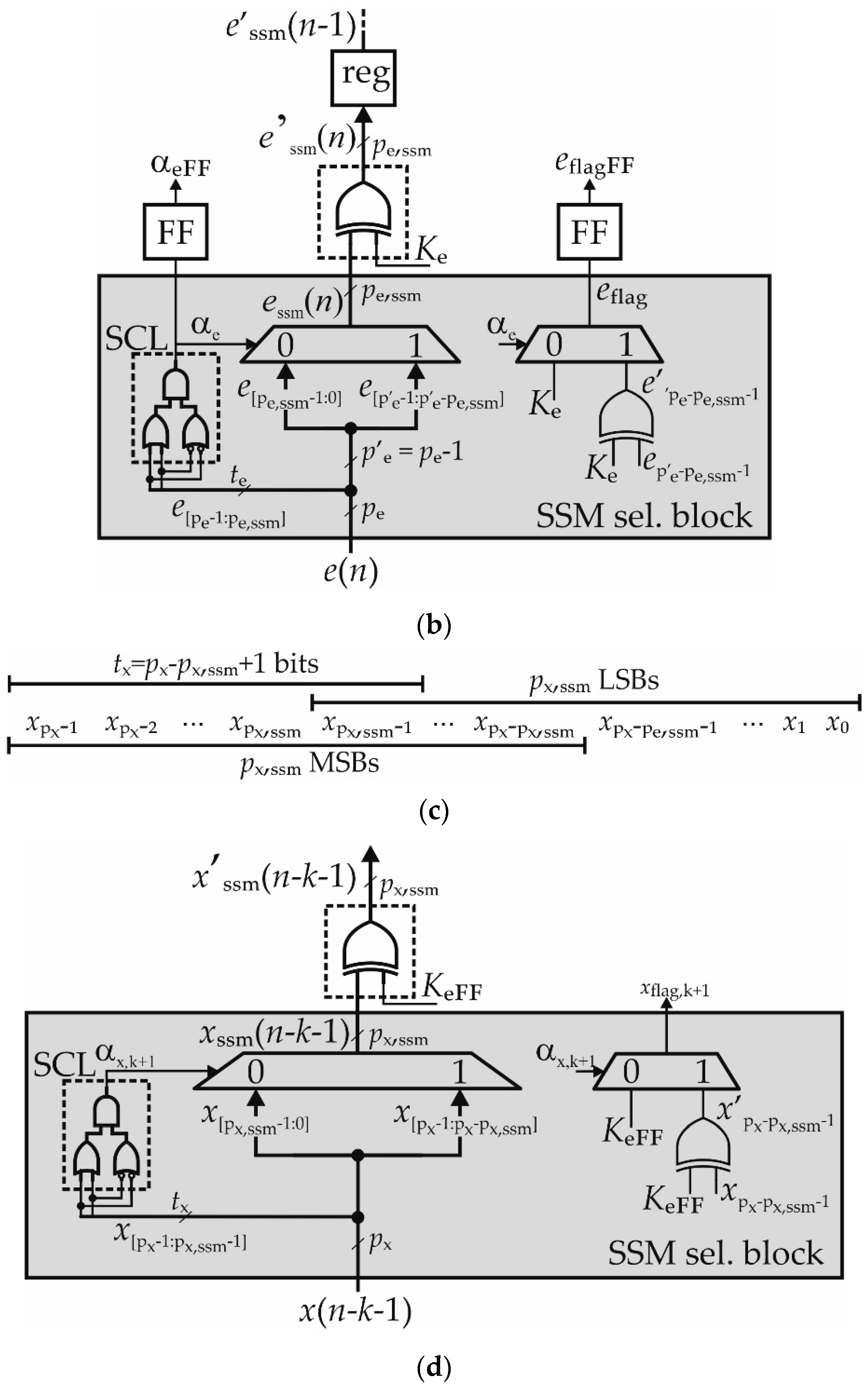
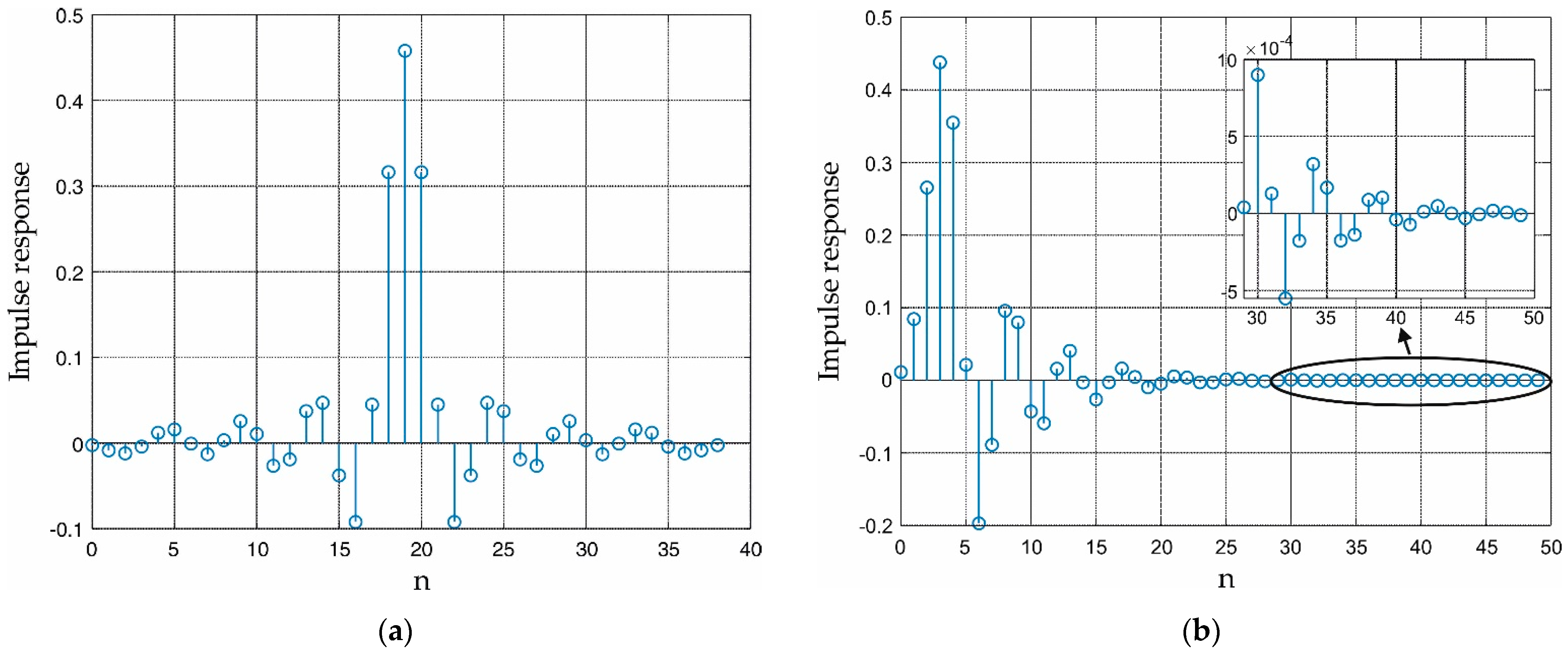
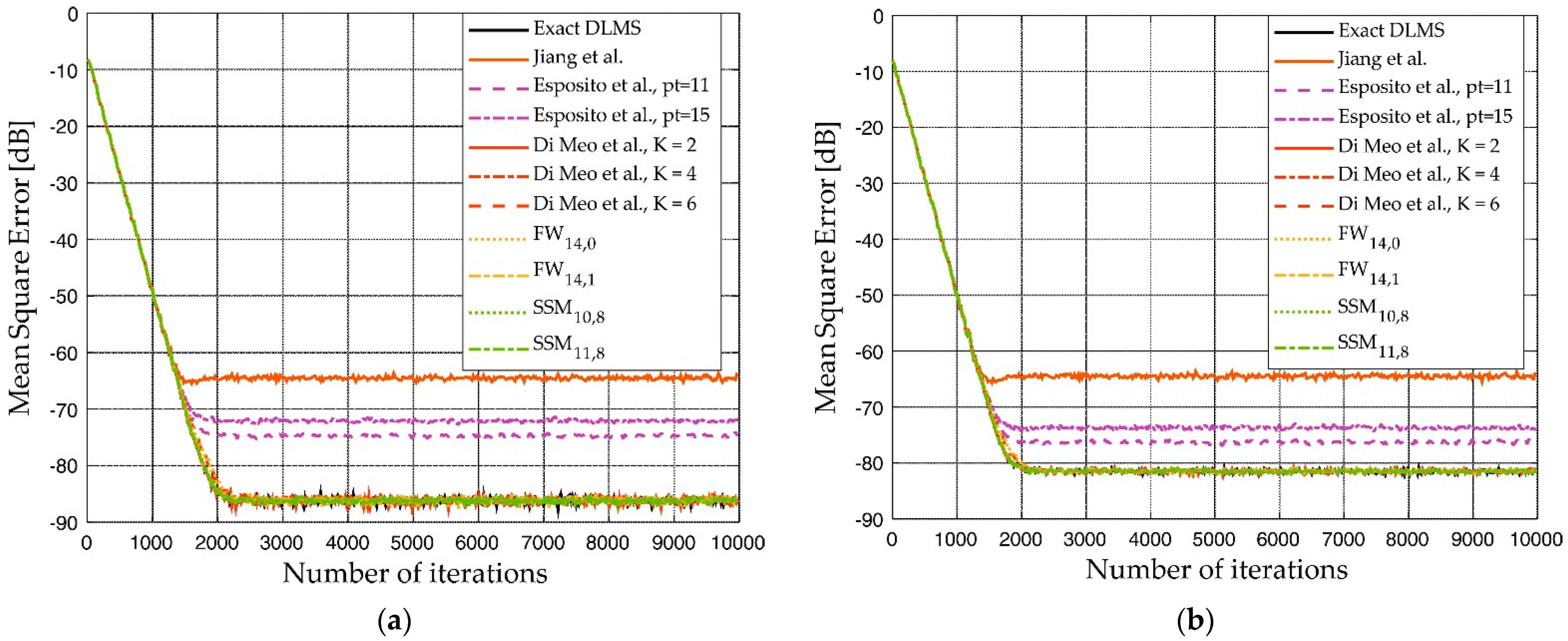
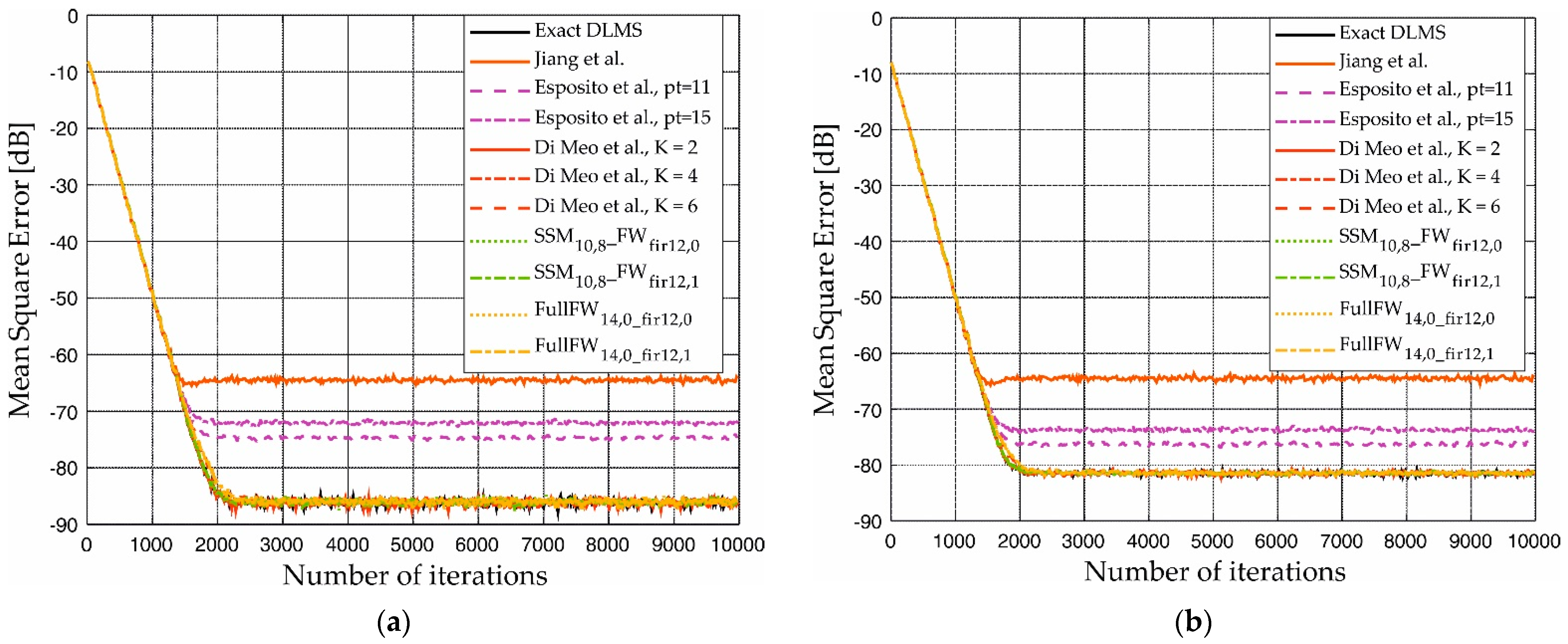

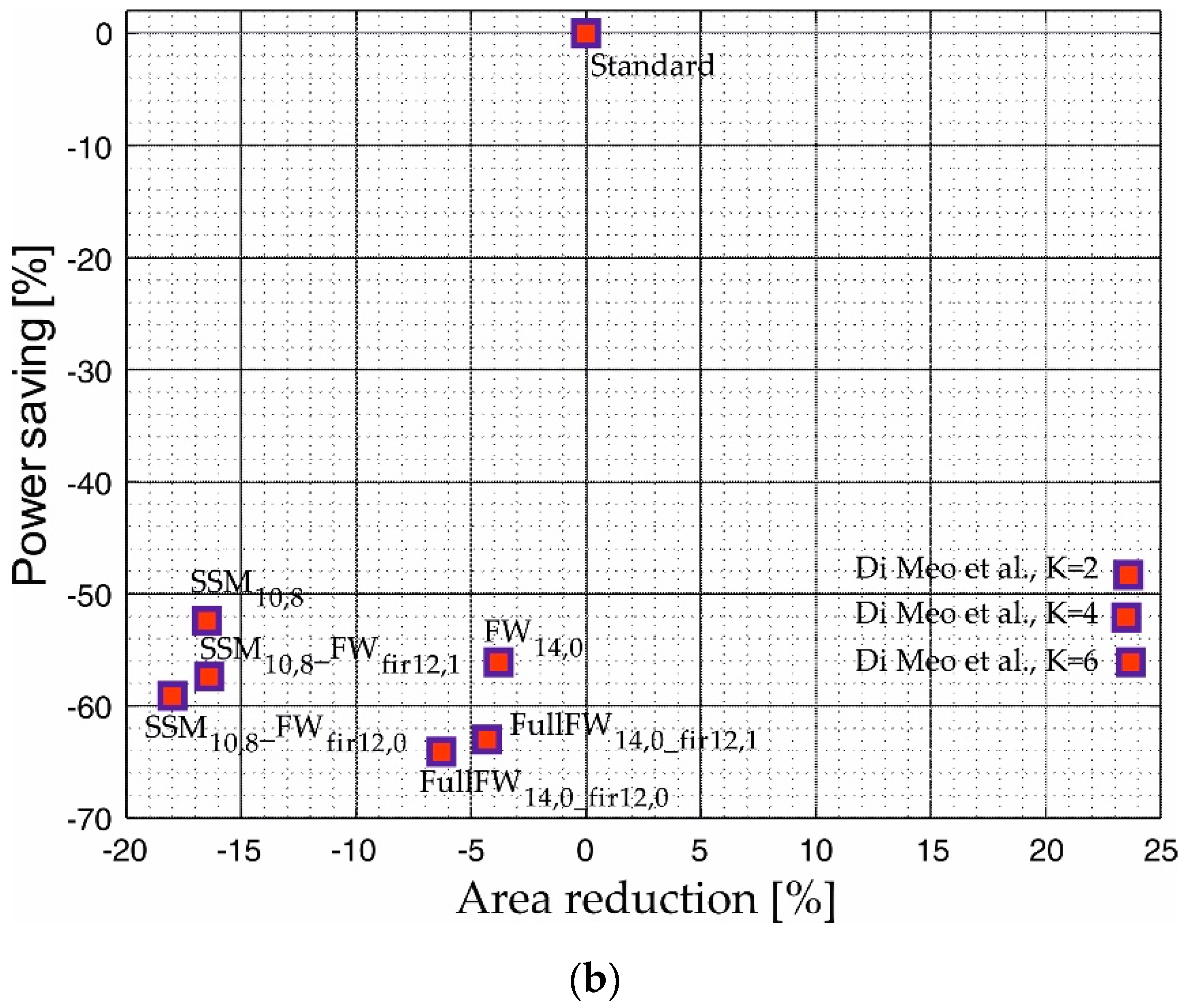
| DLMS Implementation | FIR Identification | IIR Identification | |
|---|---|---|---|
| Standard | - | −86.16 dB | −81.47 dB |
| Jiang et al. [20] | - | −64.50 dB | −64.45 dB |
| Esposito et al. [37] | pt = 11 | −74.70 dB | −76.27 dB |
| pt = 12 | −72.10 dB | −73.70 dB | |
| Di Meo et al. [41] | K = 2 | −86.16 dB | −81.47 dB |
| K = 4 | −86.15 dB | −81.46 dB | |
| K = 6 | −85.98 dB | −81.36 dB | |
| This paper, FW14,0 | −86.09 dB | −81.43 dB | |
| This paper, FW14,1 | −86.09 dB | −81.43 dB | |
| This paper, SSM10,8 | −86.16 dB | −81.47 dB | |
| This paper, SSM11,8 | −86.15 dB | −81.47 dB | |
| DLMS Implementation | FIR Identification | IIR Identification | |
|---|---|---|---|
| Standard | - | −86.16 dB | −81.47 dB |
| Jiang et al. [20] | - | −64.50 dB | −64.45 dB |
| Esposito et al. [37] | pt = 11 | −74.70 dB | −76.27 dB |
| pt = 12 | −72.10 dB | −73.70 dB | |
| Di Meo et al. [41] | K = 2 | −86.16 dB | −81.47 dB |
| K = 4 | −86.15 dB | −81.46 dB | |
| K = 6 | −85.98 dB | −81.36 dB | |
| This paper, SSM10,8_FWfir12,0 | −85.98 dB | −81.44 dB | |
| This paper, SSM10,8_FWfir12,1 | −86.06 dB | −81.46 dB | |
| This paper, FullFW14,0_fir12,0 | −85.93 dB | −81.39 dB | |
| This paper, FullFW14,0_fir12,1 | −86.00 dB | −81.41 dB | |
| DLMS Implementation | Area [mm2] | Dynamic Power [µW/MHz] | ||
|---|---|---|---|---|
| FIR Identification | IIR Identification | |||
| Standard | 0.069 | 92.91 | 104.94 | |
| Jiang et al. [20] | 0.047 (−32.6%) | 47.31 (−49.1%) | 45.61 (−56.5%) | |
| Esposito et al. [37] | pt = 11 | 0.065 (−5.9%) | 91.45 (−1.6%) | 103.08 (−1.8%) |
| pt = 12 | 0.061 (−12.2%) | 90.59 (−2.5%) | 113.92 (+8.6%) | |
| Di Meo et al. [41] | K = 2 | 0.086 (+23.6%) | 50.80 (−45.3%) | 54.26 (−48.3%) |
| K = 4 | 0.086 (+23.5%) | 48.97 (−47.3%) | 50.25 (−52.1%) | |
| K = 6 | 0.086 (+23.7%) | 46.45 (−50.0%) | 46.07 (−56.1%) | |
| This paper, FW14,0 | 0.067 (−3.8%) | 46.93 (−49.5%) | 46.06 (−56.1%) | |
| This paper, SSM10,8 | 0.058 (−16.5%) | 49.01 (−47.3%) | 50.00 (−52.4%) | |
| This paper, SSM10,8_FWfir12,0 | 0.057 (−18.0%) | 42.09 (−54.7%) | 42.97 (−59.1%) | |
| This paper, SSM10,8_FWfir12,1 | 0.058 (−16.4%) | 42.91 (−53.8%) | 44.75 (−57.4%) | |
| This paper, FullFW14,0_fir12,0 | 0.065 (−6.3%) | 38.33 (−58.8%) | 37.69 (−64.1%) | |
| This paper, FullFW14,0_fir12,1 | 0.066 (−4.3%) | 39.45 (−57.5%) | 38.78 (−63.0%) | |
Publisher’s Note: MDPI stays neutral with regard to jurisdictional claims in published maps and institutional affiliations. |
© 2022 by the authors. Licensee MDPI, Basel, Switzerland. This article is an open access article distributed under the terms and conditions of the Creative Commons Attribution (CC BY) license (https://creativecommons.org/licenses/by/4.0/).
Share and Cite
Di Meo, G.; De Caro, D.; Petra, N.; Strollo, A.G.M. A Novel Low-Power High-Precision Implementation for Sign–Magnitude DLMS Adaptive Filters. Electronics 2022, 11, 1007. https://doi.org/10.3390/electronics11071007
Di Meo G, De Caro D, Petra N, Strollo AGM. A Novel Low-Power High-Precision Implementation for Sign–Magnitude DLMS Adaptive Filters. Electronics. 2022; 11(7):1007. https://doi.org/10.3390/electronics11071007
Chicago/Turabian StyleDi Meo, Gennaro, Davide De Caro, Nicola Petra, and Antonio G. M. Strollo. 2022. "A Novel Low-Power High-Precision Implementation for Sign–Magnitude DLMS Adaptive Filters" Electronics 11, no. 7: 1007. https://doi.org/10.3390/electronics11071007
APA StyleDi Meo, G., De Caro, D., Petra, N., & Strollo, A. G. M. (2022). A Novel Low-Power High-Precision Implementation for Sign–Magnitude DLMS Adaptive Filters. Electronics, 11(7), 1007. https://doi.org/10.3390/electronics11071007







